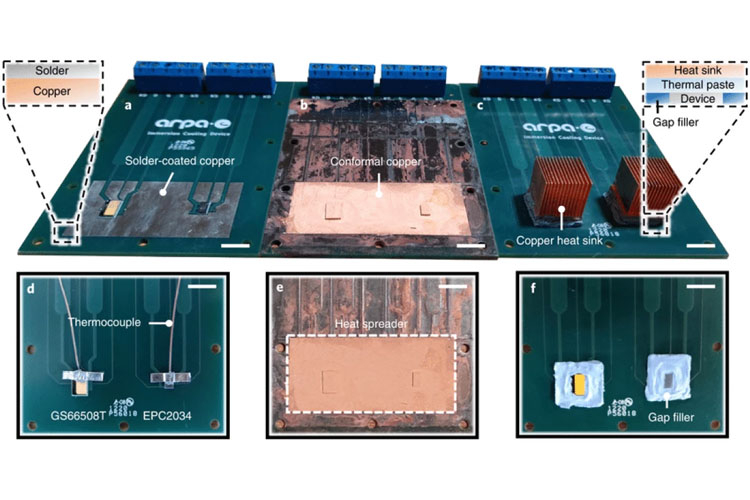Scientists continue to search for the most efficient ways to remove heat from electronic devices. In a new study, a team from the University of Illinois and UC Berkeley has shown a new cooling method that is 740% more efficient than heatsinks, thermal pastes, and other traditional heat dissipation methods.

Board with conformal copper plating in the center. Image Source: University of Illinois
One of the bottlenecks in heat dissipation has been and remains the contact area of the heatsink with the surface of chips or other surfaces of electronic devices that need to be cooled. In addition, the lower part of the heatsink heats up the most, which makes it difficult to effectively cool nearby areas of the same printed circuit board. The scientists, whose study was published in the prestigious journal Nature Electronics , solved both of these problems in one trick.
The printed circuit board and the electronic components on it were coated with a layer of poly-para-xylylene (Parylene C). It is a dielectric material and a common PCB coating for protection against oxidation and other environmental influences. The second step was the application of a copper coating over the dielectric. Copper was applied as a protective coating in a continuous layer. Thanks to the Parylene C layer, it could not short-circuit the electronic circuits and at the same time lay down on all open surfaces from all sides, becoming something like a solid heatsink and, in fact, becoming one with the electronic components.
First, copper was vapor-deposited in a vacuum, which allowed a layer of 20 nm to be deposited, and then 50 nm was added by electrolysis. Electrolysis made it possible to apply copper to all unaffected places, which made it possible to cover all surfaces on the board and chips in this way.

Image Source: University of Illinois
Experiments have shown that such a conformal copper coating copes with heat removal from electronic boards no worse than traditional methods in the complete absence of heavy heatsinks. Moreover, boards coated in this way can be installed in a larger number in a limited volume of cases and this will only improve heat dissipation. At the stand, scientists showed that the efficiency of heat removal can be increased up to 8.4 times.
Research has confirmed that this conformal copper coating is suitable for use in air and water cooling systems, although further testing is needed to see how durable this solution will be in boiling water, boiling dielectric liquids, high voltage applications, and more complex circuits. than the simple test stands used in the study.
If you notice an error, select it with the mouse and press CTRL + ENTER.




